
27 years ago I was a soldier in the Romanian army. At that time, military service was compulsory for men in my country. But its length was also dependent on wether you took an exam to a higher education institution (the equivalent of the bachelor degree, I guess) or not. The lucky ones, among which I was, were only forced to do 9 months, whereas the unlucky ones had to do one year and 9 months, more than double the time.
The first two months of my service were hard, really hard. We had to cope not only with the inherent difficulties of the life of a soldier (ruthless discipline, learning fighting skills, extreme frugality) but we also had to face the psychological effects of the continuous surveillance of the infamous Securitate.
And then, one night, it just got brutal.
Just two months after I started to serve, a series of events called "the Romanian Revolution" abruptly unfolded starting with December 16th 1989. As soldiers, we went through all the 4 conflict protocols in less than 24 hours. There were 2 exercise protocols and then 2 war protocols. We just went through them in a day. I didn't sleep for 5 nights and 6 days in a row. It was war. A war for which I was barely prepared, with only 2 months of being a soldier.
From This Point On...
...The real story should unfold. What you've just read is just an anchoring technique. I call this "the personal story technique".
But, first of all, what is an anchoring technique?
Simply put, an anchoring technique is an attention driver. The decision to read or not to read something is usually taken during the first 5 seconds. This is not scientific information, by the way, it's just my own personal observation. Some people may have a shorter attention span or a longer one. But the truth is that the first couple of sentences of your article should be enticing enough for the reader in order to guarantee at least a few more paragraphs.
This became increasingly obvious during the last 10 years, when social media shortened this attention span even more. Bombarded with information from more and more sources, the potential receiver of our message is less and less able to receive it.
An anchoring technique works by defining a context for your story. The context may be space bounded, time bounded, emotion bounded and so on. The story I used at the beginning of this article was time and emotion bounded. I started with a clear time interval and I ended it with a mix of feelings (surprise and anxiety). If in my audience here, on Steemit, there were more people from Romania, I would have certainly used the space element as well, mentioning the city of Timisoara, where I was doing my military service, because it carries a specific meaning for those people.
This personal story created both an expectation and a mental empty space for my readers. They are expecting more details and the mental space is waiting to be filled with those details.
How can you use this in your writing? Well, there are a few points that needs to be respected, but as you can imagine, there's nothing set in stone. These are just a few guidelines:
- you should use at least 2 components out of 3: space, time and / or feeling
- the story should be relevant to the topic of your article. In my case, the topic of my article would have been resilience. But if I would write about cooking I wouldn't use that story
- the story shouldn't be more than one third of your article. Write first the story and if it becomes too big, cut mercilessly
- the story should be personal. You can of course use other, more broad stories, but these are covered in the next two sessions (about using quotes / citations and research). A personal story always gives more consistency to an article, no matter the topic.
- your story should be true. Meaning, real, it should be something that you really experienced. Of course, hardly anyone would verify your story, but that's not a reason to lie. It's bad for your karma. Seriously.
With that being said, let's go to the first assignment:
Write an article on a topic of your choice, using a personal story as an anchoring technique. The article can be about anything, but it should have at least 600 words, one third of them being your personal story, and the personal story should have at least 2 components out of 3 (space, time, emotion). Tag your article with challenge30 and story and leave a comment with the title and link.
I will personally read all the articles and I will award the winner with the ginarmous amount of 1SBD (all symbolic, of course). Please understand that picking the winner will be an expression of my own preferences and it doesn't mean your article is not good.
You have 24 hours to write your article, I will post the winner tomorrow evening. My timezone is GMT+2.
Looking forward to read your stories!
This is a 15 sessions story telling crash-course I'm doing on Steemit, the goal being to improve the writing skills of all members of this community. You can see the list of the sessions here. Each session contains an assignment for which you have 24 hours. I will read and review all the assignments, and award a symbolic prize of 1SBD to the "winner".
Let's tell some stories and have some fun!
I'm a serial entrepreneur, blogger and ultrarunner. You can find me mainly on my blog at Dragos Roua where I write about productivity, business, relationships and running. Here on Steemit you may stay updated by following me @dragosroua.

https://steemit.com/~witnesses
